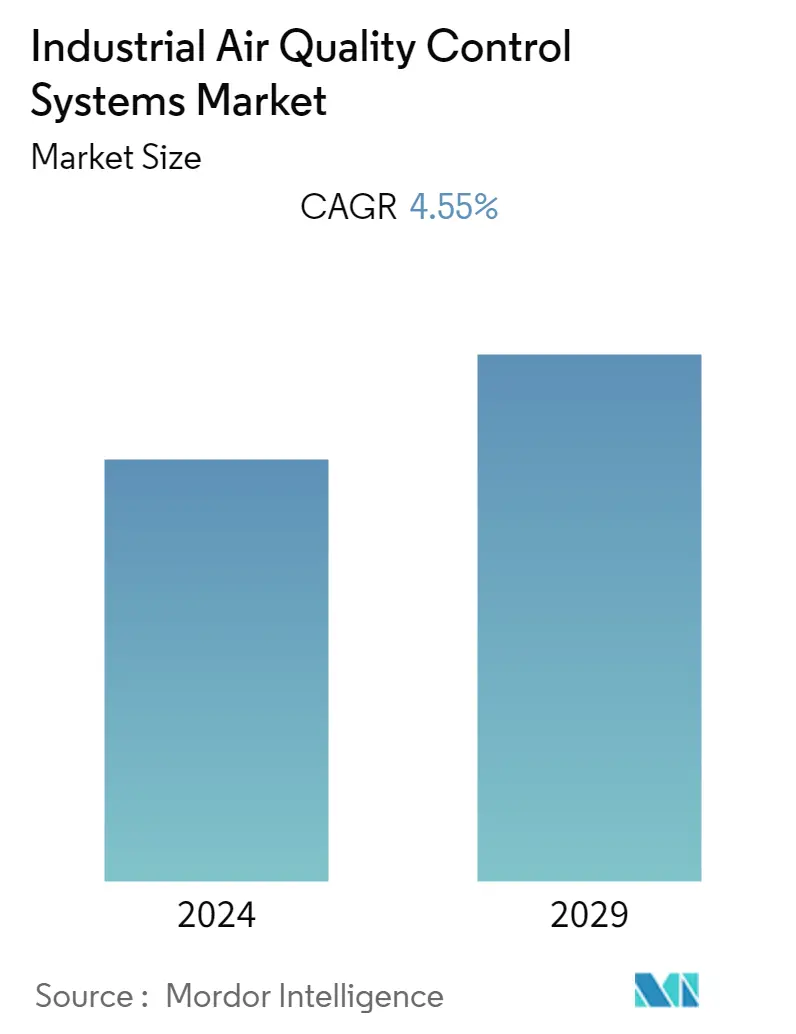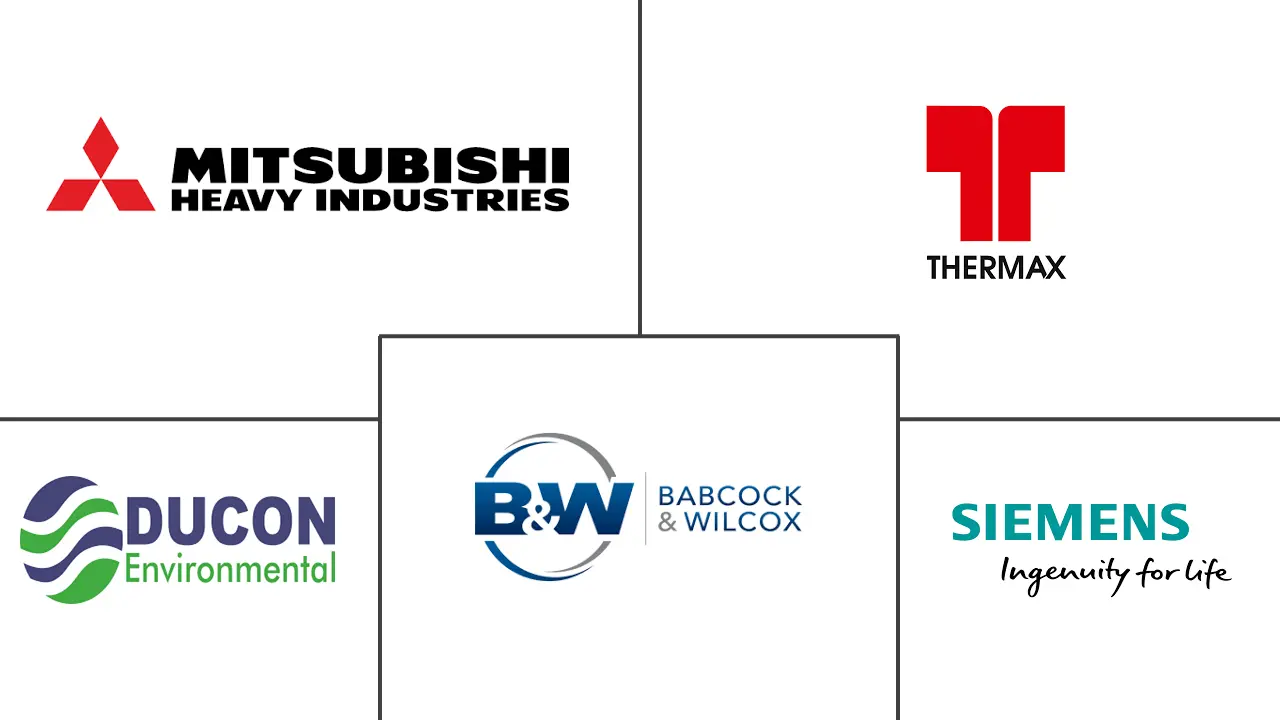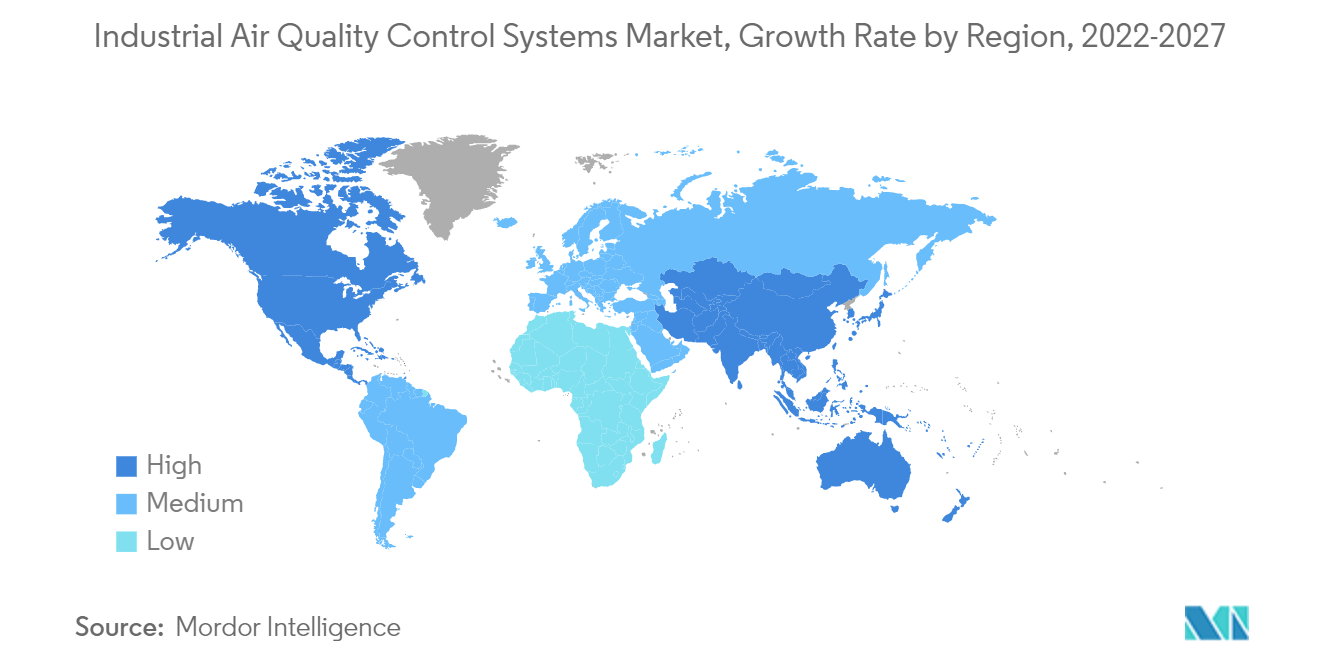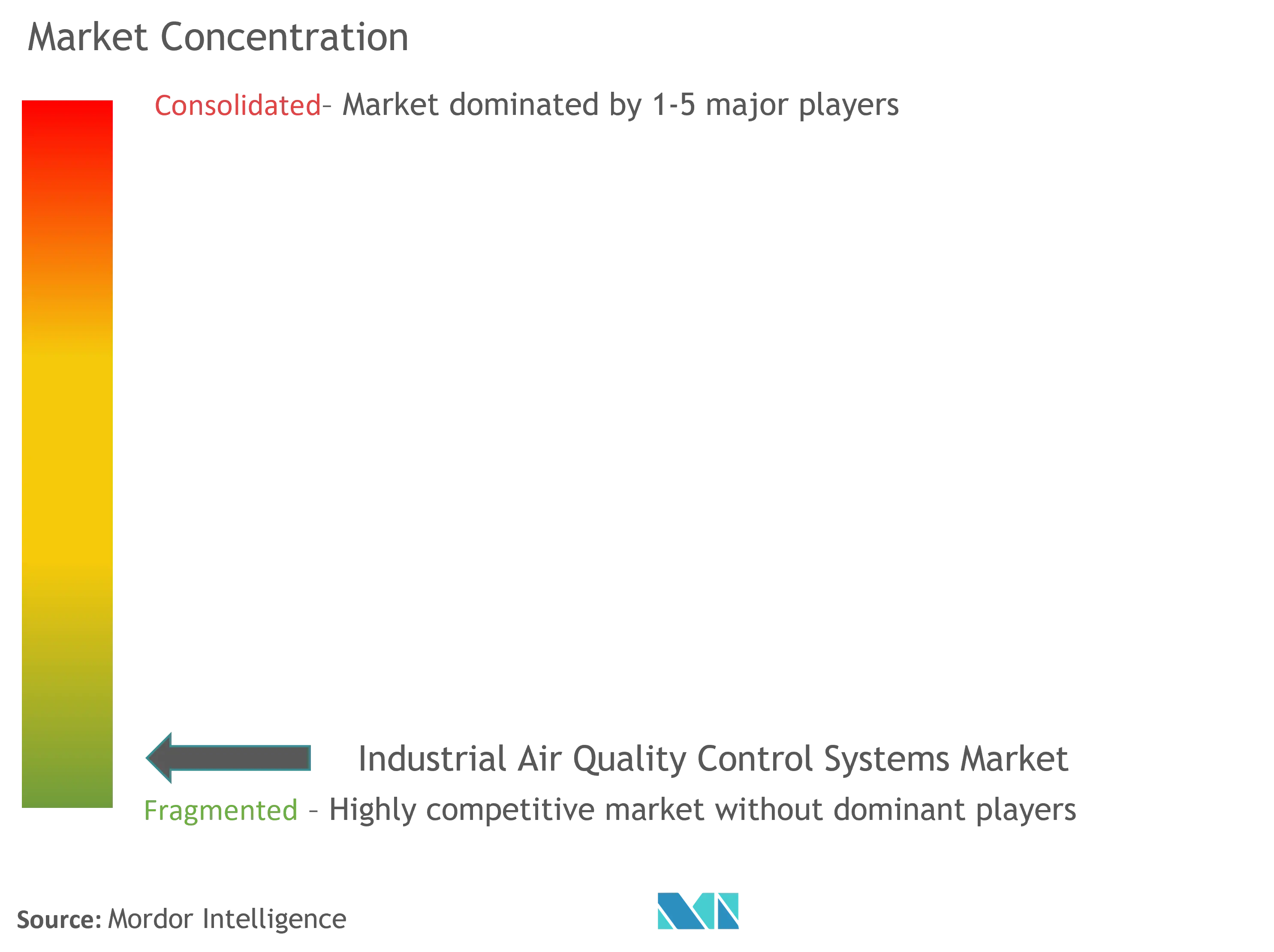Industrial Air Quality Control Systems Market Size

| Study Period | 2020 - 2029 |
| Base Year For Estimation | 2023 |
| CAGR | 4.55 % |
| Fastest Growing Market | Asia-Pacific |
| Largest Market | North America |
| Market Concentration | Low |
Major Players
*Disclaimer: Major Players sorted in no particular order |
Industrial Air Quality Control Systems Market Analysis
The market for industrial air quality control systems is expected to register a CAGR of approximately 4.55% during 2022 - 2027. The COVID-19 pandemic has had a negative impact on the industrial air quality control systems market due to the shutdown of various industries and power generation plants worldwide. Major factors driving the market are the growing awareness among consumers, stringent air quality control regulations, and increasing awareness among the common mass to mitigate health risks. However, the emergence of alternative and renewable sources of energy with zero emissions and high capital required for the installation of an air quality control system is expected to hinder the growth of the market studied.
- The power generation sector is dominating the market with significant growth during the forecast period, owing to the increasing pollution and growing industrialization.
- Retrofitting old industries with air quality control systems to meet stringent regulatory norms set up by the government will be a great opportunity in the future.
- Asia-Pacific is the fastest growing region, with countries like China and India, with growing industrialization and construction activities leading to the increasing demand for air quality control systems.
Industrial Air Quality Control Systems Market Trends
This section covers the major market trends shaping the Industrial Air Quality Control Systems Market according to our research experts:
Power generation Industry is Expected to Dominate the Market
- In the power generation sector, power plants are the largest sources of emission of SO2, mercury, and acid gases. In the power sector, coal accounts for around 98 per cent of SO2 emissions, 94 per cent of mercury emissions, 86 per cent of NOx emissions, and 83 per cent of fine particulate emissions. Also, coal is the world's largest single source of electricity, set to still contribute 22 per cent in 2040.
- Coal accounted for 36.5 per cent of global electricity generation in 2021. This was up from 35.3 per cent the previous year, with total coal-fired electricity generation has reached over 10,000 terawatt hours. The production of harmful gases can be minimized using air quality control systems (AQCS), such as electrostatic precipitators, flue gas desulfurizers, scrubbers and mercury control systems.
- The growing concerns regarding environmental pollution and government actions to curb the same are driving the market. Also, stringent regulations, such as the Clean Air Act (CAA) and the Mercury and Air Toxics Standard, enforce the installation of systems that monitor and curb emissions to bring them to a safer level in power generation companies using fossil fuels.
- Moreover, air quality control systems (AQCS) in the power generation industry are used to clean gases emitted from thermal power plants. Numerous countries across the globe are heavily dependent on coal-fired power plants for the generation of electricity. For instance, One of the classic examples is the Zainskaya combined cycle power plant, an 858MW power plant in the construction phase in Russia. The power plant is located in Tatarstan, the expected completion year is 2023.
- Furthermore, gas-fired power generation is gaining significant momentum in the global market due to the demand for cleaner power generation and the development of a robust gas supply infrastructure in natural gas-rich countries like Russia, Saudi Arabia, Iran, and Qatar. Many upcoming power projects in the aforesaid countries are based on natural gas.
- Hence, increasing electricity generation, coupled with the changing power generation industry dynamics, is expected to drive the industrial air quality control systems market during the forecast period.

Asia-Pacific Region is Fastest Growing Region
- The growth in the industrial sector (which includes power generation, chemicals and metal processing) has influenced the demand for air quality control systems. With countries like India and China already topping the list of most polluted countries, the governments have been forced to implement various regulations for the emission standard in these countries, forcing the pathway for the implementation of AQCS in industries.
- The increasing rate of coal consumption, illegal mining have led to the deterioration of air quality. In addition, the growing per-capita energy consumption and demand for the same are the major factors responsible for the high levels of GHG emissions. To control rising emissions, the Central Pollution Control Board (CPCB) of India has implemented control norms and standards that mandate the installation of air quality control systems in all industries.
- Moreover, in August 2021, the Indian Government announced that the national ambient air quality standards would be updated in 2022. The new standards are expected to include ultrafine particulate matter which falls below PM 2.5.
- Also, in October 2021, the Indian Space Research Organisation (ISRO) and Japan Aerospace Exploration Agency (JAXA) agreed to join hands to take up activities on rice crop area and air quality monitoring using satellite data. Both agencies have signed an implementing arrangement for shared activities on rice crop area and air quality monitoring using satellite data.
- Hence, owing to the above points, the Asia-Pacific is expected to dominate the Industrial Air Quality Control Systems Market during the forecast period.

Industrial Air Quality Control Systems Industry Overview
The Industrial air quality control system market is fragmented. Some of the major companies include Mitsubishi Heavy Industries Group, Thermax Ltd, Babcock & Wilcox Enterprises, Inc, Ducon Environmental Systems, and Siemens AG.
Industrial Air Quality Control Systems Market Leaders
-
Mitsubishi Heavy Industries Group
-
Thermax Limited
-
Ducon Environmental Systems
-
Siemens AG
-
Babcock & Wilcox Enterprises, Inc.
*Disclaimer: Major Players sorted in no particular order

Industrial Air Quality Control Systems Market News
- In October 2021, TSI Incorporated announced the expansion of the TSI AirAssure Indoor Air Quality (IAQ) Monitor product line. The new product - AirAssure 8144-2, is a two-gas model designed to provide common indoor air pollutants and utilizes low-cost sensor technology to monitor carbon dioxide, total volatile organic compounds, particulate matter, and other indoor air conditions.
- In September 2021, DPD Ireland launched an air quality monitoring program, which uses smart sensors on delivery vans and buildings to track the city's (Dublin) air quality in real-time. The information is expected to be shared for free with universities, local authorities, and the public as part of a new initiative by the company.
Industrial Air Quality Control Systems Market Report - Table of Contents
1. INTRODUCTION
- 1.1 Scope of Study
- 1.2 Market Definition
- 1.3 Study Assumptions
2. RESEARCH METHODOLOGY
3. EXECUTIVE SUMMARY
4. MARKET OVERVIEW
- 4.1 Introduction
- 4.2 Market Size and Demand Forecast in USD billion, till 2027
- 4.3 Recent Trends and Developments
- 4.4 Government Policies and Regulations
- 4.5 Recent Trends and Developments
-
4.6 Market Dynamics
- 4.6.1 Drivers
- 4.6.2 Restraints
-
4.7 Porter's Five Forces Analysis
- 4.7.1 Bargaining Power of Suppliers
- 4.7.2 Bargaining Power of Consumers
- 4.7.3 Threat of New Entrants
- 4.7.4 Threat of Substitutes Products and Services
- 4.7.5 Intensity of Competitive Rivalry
5. MARKET SEGMENTATION
-
5.1 Application
- 5.1.1 Power Generation
- 5.1.2 Cement Industry
- 5.1.3 Chemical Industry
- 5.1.4 Metal and Metallurgy
- 5.1.5 Other Applications
-
5.2 Type
- 5.2.1 Electrostatic Precipitators (ESP)
- 5.2.2 Scrubbers and Flue Gas Desulfurization (FGD)
- 5.2.3 Selective Catalytic Reduction (SCR)
- 5.2.4 Fabric Filters
- 5.2.5 Other Types
-
5.3 Geography
- 5.3.1 North America
- 5.3.2 Europe
- 5.3.3 Asia Pacific
- 5.3.4 South America
- 5.3.5 Middle East and Africa
6. COMPETITIVE LANDSCAPE
- 6.1 Mergers & Acquisitions, Joint Ventures, Collaborations, and Agreements
- 6.2 Strategies Adopted by Leading Players
-
6.3 Company Profiles
- 6.3.1 Mitsubishi Heavy Industries Ltd
- 6.3.2 General Electric Company
- 6.3.3 Babcock & Wilcox Enterprises, Inc
- 6.3.4 Thermax Ltd
- 6.3.5 Ducon Technologies Inc
- 6.3.6 Amec Foster Wheeler PLC
- 6.3.7 Siemens AG
- *List Not Exhaustive
7. MARKET OPPORTUNITIES AND FUTURE TRENDS
** Subject To AvailablityIndustrial Air Quality Control Systems Industry Segmentation
The scope of the industrial air quality control systems market report includes:
| Application | Power Generation |
| Cement Industry | |
| Chemical Industry | |
| Metal and Metallurgy | |
| Other Applications | |
| Type | Electrostatic Precipitators (ESP) |
| Scrubbers and Flue Gas Desulfurization (FGD) | |
| Selective Catalytic Reduction (SCR) | |
| Fabric Filters | |
| Other Types | |
| Geography | North America |
| Europe | |
| Asia Pacific | |
| South America | |
| Middle East and Africa |
Industrial Air Quality Control Systems Market Research FAQs
What is the current Industrial Air Quality Control Systems Market size?
The Industrial Air Quality Control Systems Market is projected to register a CAGR of 4.55% during the forecast period (2024-2029)
Who are the key players in Industrial Air Quality Control Systems Market?
Mitsubishi Heavy Industries Group, Thermax Limited, Ducon Environmental Systems , Siemens AG and Babcock & Wilcox Enterprises, Inc. are the major companies operating in the Industrial Air Quality Control Systems Market.
Which is the fastest growing region in Industrial Air Quality Control Systems Market?
Asia-Pacific is estimated to grow at the highest CAGR over the forecast period (2024-2029).
Which region has the biggest share in Industrial Air Quality Control Systems Market?
In 2024, the North America accounts for the largest market share in Industrial Air Quality Control Systems Market.
What years does this Industrial Air Quality Control Systems Market cover?
The report covers the Industrial Air Quality Control Systems Market historical market size for years: 2020, 2021, 2022 and 2023. The report also forecasts the Industrial Air Quality Control Systems Market size for years: 2024, 2025, 2026, 2027, 2028 and 2029.
Industrial Air Quality Control Systems Industry Report
Statistics for the 2024 Industrial Air Quality Control Systems market share, size and revenue growth rate, created by Mordor Intelligence™ Industry Reports. Industrial Air Quality Control Systems analysis includes a market forecast outlook to 2029 and historical overview. Get a sample of this industry analysis as a free report PDF download.



